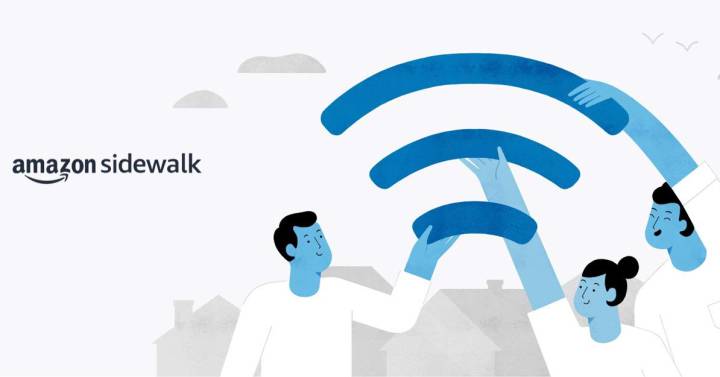Amazon does not offer a slew of new products and services. The tech giant announced that on June 8 all the company’s Alexa-enabled devices (Echo speakers, cameras, Ring doorbells…) will be connected to a wireless network, denominada Amazon Sidewalk. They will do this automatically, using Bluetooth and radio signals in the 900MHz band, unless users change the settings,
Amazon’s new service assumes that users will share a small portion of their internet connection with their nearest neighbors when they don’t have one, thus allowing devices to connect to the network.
Device connections to the network are free and according to the company, the network won’t use as much bandwidth, since the server side’s maximum bandwidth of the Sidewalk Bridge is 80kbps, and the total monthly data used for each account is limited to 500MB.
“We are talking about how Amazon is creating authentic neighborhoods that are connected wirelessly. It will create a huge network based on all the devices in the company. To understand the scale, it is enough to know that only in the United States, where the project begins, the devices of the Amazon Echo range exceeded 100 million units in 2019 , and sold security cameras, smart doorbells and alarms from Ring alone. In 2020, it exceeded 1.4 million units,” says Enrique Danes, professor at IE Business School.
Dans points out that Amazon’s goal is to become an IoT (Internet of Things) network operator, relying on Wi-Fi networks for its users. That is, without the need to deploy any additional infrastructure. “Amazon is aware of the potential of the Internet of Things, has recognized a loss of profit (the millions of smart devices it has sold) and wants to connect them together to see what business they can make from there.”
First of all, Amazon will already offer a service with its interlocking network to Tile, a leader in creating small object locators to quickly locate lost objects and thus be able to compete with Apple’s latest proposal, AirTags, which would allow the iPhone manufacturer to also build a massive network It depends on all users’ devices around the world,” continues Dan.
But Amazon, this professor points out, didn’t launch Sidewalk to serve just one company. His idea is to create a platform that can be used by third parties. Dans insists he “want to become an Internet of Things provider”. As such, it provides Sidewalk Developer Services, a set of certified silicon chips along with development boards, device software development kits, and other tools for developers who want to take advantage of Amazon Sidewalk functionality.
For Fernando Aparicio, CEO of Amvos Digital, “There is no doubt that Amazon wants to become an operator. Despite the very limited bandwidth in its proposal, it is another step to try and attack the telecom sector.” Aparicio recalls in this context the agreement Amazon struck two years ago with Iridium, the world’s largest satellite network, or Project Kuiper, Elon Musk’s giant Starlink alternative, which wants to build a network of more than 3,000 satellites to deliver the entire Internet. around the world.
This expert adds that Google’s abandonment of Project Loon, with the same philosophy of providing connectivity to remote regions of the planet, “leaves Starlink and Kuiper as Challengers To change the telecommunications infrastructure on the planet, and in the case of Amazon, as a potential service in the future being integrated into this massive loyalty machine called Amazon Prime which, remember, is a package of services with virtually no competition in the marketplace where connectivity will be icing on the cake.”
Advantages and risks
Amazon Sidewalk will only be available in the US for now. Although it appears that the company’s goal is to expand to other countries, it has not yet reported concrete plans. The multinational has made it clear that it intends with this network to make devices work better and simplify the process of setting up a new Alexa device. It will also help extend the reach of low-bandwidth devices such as trackers or pet trackers.
Another advantage, according to Amazon, is that it will allow more devices to be connected if the Internet fails or if the computer is left without coverage. The tech giant, for example, notes that if an Echo device loses its Wi-Fi connection, it’s possible with Sidewalk to reconfigure it to reconnect it to the router. And for Ring devices, they can continue to receive alerts at home even if the Internet connection is lost.
Although some voices have highlighted the security risks that could arise, recalling the history of insecure wireless technologies such as Wi-Fi and Bluetooth, Amazon maintains that they are perfectly safe to use. According to the company, it uses multiple layers of privacy and security to protect data traveling over the network and keep customers safe.
To deactivate Sidewalk, the user has to open the Alexa app, press the More button and then the Account Settings button. Once there, the app gives you the ability to disable it.

“Problem solver. Proud twitter specialist. Travel aficionado. Introvert. Coffee trailblazer. Professional zombie ninja. Extreme gamer.”




More Stories
Below is the schedule of pension payments as of July 2022. Find out what benefits you will get after the changes [17.07.2022]
Overview of the new electric sports cars for the Hyundai Ioniq 5 N and Ioniq 6 N
Portugal has launched a floating solar power plant. It is the largest structure of this type in Europe – Economy